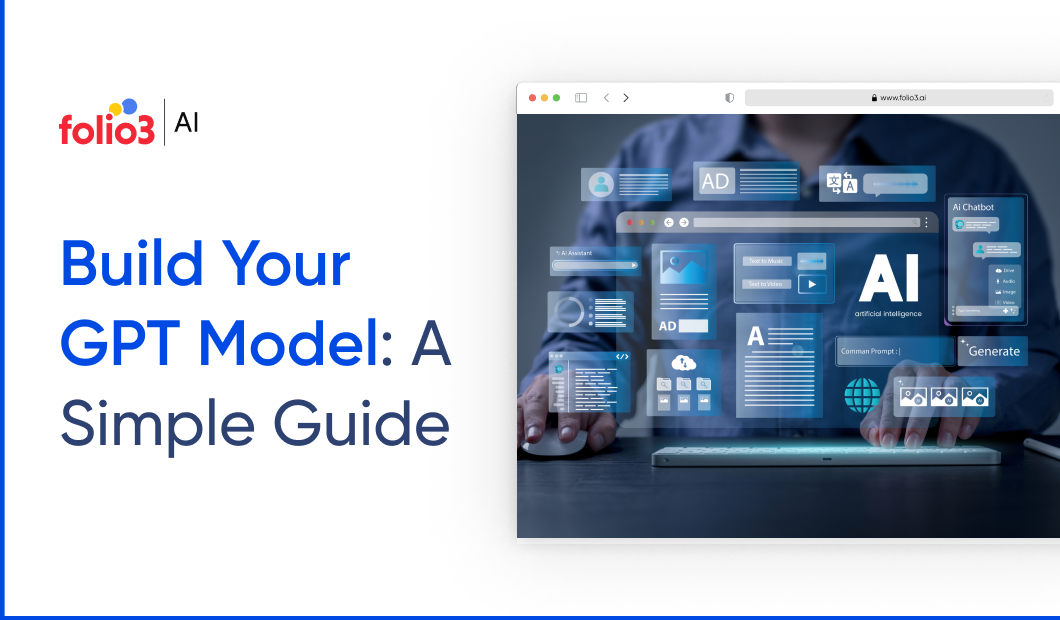LetŌĆÖs assume you run an e-commerce business. Customers frequently ask about delivery times, product availability, and return policies. Instead of relying on a support team, you build an AI assistant that answers these questions instantly.
This is what GPT models can doŌĆöunderstand and generate human-like text for specific tasks. The best part? You can customize one to suit your business needs.
Building your own GPT model doesnŌĆÖt have to be complicated. With the right tools and clear steps, itŌĆÖs manageable. weŌĆÖll walk you through the essentials of GPT models, from understanding what they are to creating and optimizing them for your use case.
What is a GPT Model?
A GPT model is an AI tool designed to understand and create human-like text. ItŌĆÖs built on a transformer architecture, which is highly effective at processing sequences like language. These models are pre-trained on massive datasets, allowing them to grasp grammar, facts, and the context between words.
What sets GPT apart is its versatility. Each task doesnŌĆÖt need custom coding. Instead, it can adapt to various applications, like chatbots, virtual assistants, content creation, or summarizing documents, simply by using the right input. This flexibility makes it a powerful solution for many text-based tasks.
Overview of GPT Models
The GPT architecture, developed by OpenAI, is based on the Transformer model introduced in 2017. Since its inception, several versions of GPT have been released, each more advanced than the last. The most notable versions include:
- GPT-1: The first version, launched in 2018, demonstrated that transformers could be used to generate coherent text. It had a relatively small number of parameters compared to later versions.
- GPT-2: Released in 2019, GPT-2 showcased improvements in text generation, with 1.5 billion parameters. It garnered attention for its ability to generate increasingly realistic text and perform a variety of natural language processing (NLP) tasks.
- GPT-3: The most widely known version, with 175 billion parameters, GPT-3 is capable of understanding complex prompts and generating highly sophisticated responses. Its vast capabilities have made it a go-to model for businesses looking to integrate AI into their services.
- GPT-4: The latest iteration, which continues to improve upon GPT-3ŌĆÖs capabilities by refining understanding, coherence, and response quality.
Each version of GPT builds upon the last, continually expanding its ability to understand and generate human-like language across a broader range of contexts.
Use Cases of GPT Models
GPT models have found applications in a wide range of industries and tasks. Some of the most common use cases include:
- Customer Service and Chatbots: GPT-powered chatbots can provide instant, human-like responses, improving customer support efficiency and satisfaction.
- Content Creation: GPT models can assist writers by generating blog posts, product descriptions, and even entire articles, helping businesses scale their content operations.
- Translation and Summarization: GPT models excel at translating languages and summarizing long pieces of text into concise, readable formats.
- Code Writing and Debugging: Developers use GPT models to generate code snippets, assist with debugging, and automate repetitive coding tasks.
- Personal Assistants: GPTs are integrated into virtual assistants to offer more nuanced and context-aware responses, improving user experiences.
- Healthcare: GPT models can support healthcare professionals by summarizing patient records, providing medical insights, and even generating reports based on research.
- Education: GPT models can be used for tutoring, answering student queries, and creating personalized educational content.
Advantages of Building GPT Models
Building your own GPT model can offer several advantages:
- Customization: By building your own GPT model, you can tailor it to meet the specific needs of your business. Whether itŌĆÖs generating content, providing customer support, or analyzing data, your model can be fine-tuned to excel in your chosen application.
- Scalability: Custom models can be scaled more effectively to meet the growing needs of your business, ensuring that your AI system can handle larger datasets and more complex tasks as you grow.
- Cost Efficiency: While pre-trained models like GPT-3 are widely available, building your own model can help you avoid ongoing licensing fees and provide more control over performance and usage.
- Security and Privacy: By training your model on your own data, you can ensure that sensitive business information remains secure and private, without relying on third-party providers.
- Innovation: Building a GPT model enables you to push the boundaries of whatŌĆÖs possible in your industry. You can experiment with new use cases, improve on existing technologies, and create unique solutions that differentiate your business.
Working Mechanism of GPT Models
At the core of GPT models is the Transformer architecture, which relies on attention mechanisms to process and generate sequential data. HereŌĆÖs how the process works:
- Pre-training: GPT models are pre-trained on massive datasets. During this phase, the model learns grammar, facts, and language structure by predicting the next word in a sentence based on previous words. This is done across billions of words, allowing the model to develop a deep understanding of language.
- Fine-tuning: After pre-training, GPT models are fine-tuned on specific tasks or datasets. For example, if you’re building a chatbot, the model may be fine-tuned on customer service conversations to enhance its understanding of customer inquiries.
- Text Generation: Once trained and fine-tuned, the GPT model can generate text based on a prompt. It does this by predicting the next word or phrase in a sequence, ensuring that the generated text is coherent and contextually relevant.
- Feedback Loop: As the GPT model interacts with users or processes data, feedback can be used to continuously improve its performance. This iterative process enhances the modelŌĆÖs ability to handle more complex tasks and generate more accurate text.
How to Choose the Right GPT Model for Your Needs?
Choosing the right GPT model depends on several factors, including the specific use case, data availability, and computational resources. HereŌĆÖs what to consider:
- Task Complexity: For simple tasks like generating short responses, a smaller model like GPT-2 may suffice. For more complex applications, like understanding nuanced language or generating long-form content, GPT-3 or GPT-4 would be a better fit.
- Customization Needs: If you need a highly specialized model for tasks like medical diagnosis or legal document generation, building a custom GPT model from scratch or fine-tuning an existing model may be necessary.
- Computational Resources: Larger models like GPT-3 and GPT-4 require significant computational power for both training and inference. Consider your infrastructure and resources before choosing a model.
- Cost: While using a pre-trained model like GPT-3 can be convenient, it comes with ongoing usage costs. Building your own model can be more cost-effective in the long term, especially if you have specialized needs.
Prerequisites to Build a GPT Model
Before you can start building a GPT model, there are a few prerequisites:
- Technical Knowledge: Understanding machine learning, neural networks, and natural language processing (NLP) is essential to building and fine-tuning GPT models. Knowledge of Python and libraries like TensorFlow, PyTorch, and Hugging FaceŌĆÖs Transformers will also be required.
- Computational Resources: Training GPT models requires substantial computational power, often utilizing powerful GPUs and cloud-based infrastructure like AWS or Google Cloud.
- Data: High-quality, relevant data is essential for training GPT models. This could be text data from your industry, such as customer queries, product descriptions, or academic papers, depending on your use case.
- Time: Building and fine-tuning a GPT model is a time-consuming process, especially when working with large datasets and optimizing the model.
How to Create a GPT Model? ŌĆō Steps for Building a GPT Model
Building a GPT model involves several key steps:
- Data Collection: Gather a large, diverse dataset of text thatŌĆÖs relevant to your application. This might involve scraping websites, collecting customer feedback, or using publicly available datasets.
- Model Selection: Choose the version of GPT that fits your needs. You can start with pre-trained models like GPT-2 or GPT-3 and fine-tune them to your specific use case.
- Model Training: Train your model using the collected data. This will involve setting up the model architecture, selecting hyperparameters, and using a machine learning framework like PyTorch or TensorFlow.
- Fine-Tuning: Fine-tune the model on your specific task to improve performance. This involves adjusting the modelŌĆÖs parameters and training it on domain-specific data.
- Evaluation: Test the modelŌĆÖs performance by generating text based on sample prompts. Evaluate the quality of the output, and make adjustments as needed.
- Deployment: Once the model is trained and optimized, deploy it on your platform, whether itŌĆÖs through an API or integrated into your application.
How to Train an Existing GPT Model with Your Data?
Training an existing GPT model with your data involves fine-tuning. HereŌĆÖs how to do it:
- Prepare Your Data: Clean and format your data to ensure itŌĆÖs ready for training. This may involve tokenizing the text, removing irrelevant information, and splitting it into training and validation datasets.
- Set Up the Environment: Use machine learning libraries such as Hugging Face, TensorFlow, or PyTorch to set up the training environment. YouŌĆÖll also need access to GPUs for efficient training.
- Fine-Tune the Model: Load the pre-trained GPT model and fine-tune it on your data. This will involve adjusting the modelŌĆÖs weights based on your specific dataset and task.
- Monitor and Optimize: Monitor the training process and fine-tune hyperparameters to optimize performance. Once youŌĆÖre satisfied with the results, you can deploy your model.
How Folio3 AI Can Assist
Building a GPT model can be challenging, but It can really simplifies the process with end-to-end support: Folio3 AI combines technical expertise and tailored solutions to make GPT development easy and impactful for your business.
Data Preparation
- Collect and clean datasets specific to your needs.
- Annotate and preprocess data for optimal training.
Model Selection
- Recommend the right GPT version for your use case.
- Balance performance, cost, and scalability.
Training & Fine-tuning
- Fine-tune pre-trained models with domain-specific data.
- Optimize parameters for better accuracy and performance.
Seamless Deployment
- Integrate the model into your existing systems via APIs.
- Ensure scalability and cross-platform compatibility.
Ongoing Support
- Monitor and improve performance over time.
- Provide updates, bug fixes, and scaling solutions.
Conclusion
Building your own GPT model is not just fun – It’s very useful for businesses looking to employ AI for tasks like customer service, content creation, and more. Making your work life easy with
over-the-top accuracy and customization. GPT models have this ability to operate in the easiest way, saving time and resources. If you’re ready to take your business work Hassle-free,Folio3 AI is here to guide you every step of the way.

Manahil Samuel holds a Bachelor’s in Computer Science and has worked on artificial intelligence and computer vision She skillfully combines her technical expertise with digital marketing strategies, utilizing AI-driven insights for precise and impactful content. Her work embodies a distinctive fusion of technology and storytelling, exemplifying her keen grasp of contemporary AI market standards.










